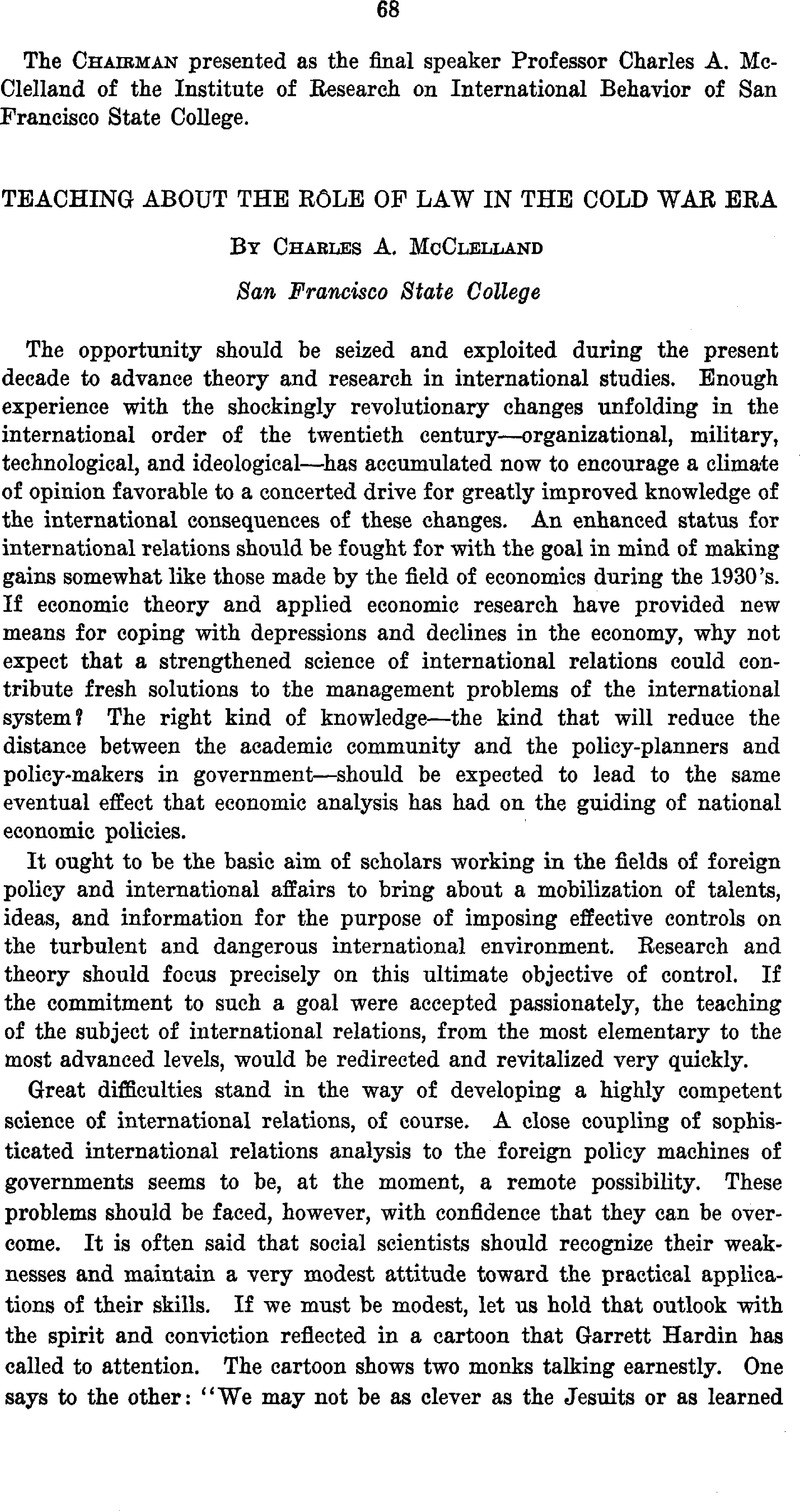No CrossRef data available.
Published online by Cambridge University Press: 27 February 2017

1 McClelland, “Unmanaged Weapons and the Calculated Control of International Politics,” 7 Journal of Conflict Eesolution 319-324 (1963).
2 Sorensen, Decision-Making in the White House: The Olive Branch or the Arrows (1963).
3 Snyder, Brock, and Sapin, Decision-Making as an Approach to the Study of International Belations (1954).
4 Eosenau, Calculated Control as a Unifying Concept in the Study of International Politics and Foreign Policy (1963).
5 Falk, “International Jurisdiction: Horizontal and Vertical Conceptions of Legal Order,” Temple Law Q. 295-320 (1959); Alger, “Comparison of Intranational and International Politics,” 57 Amer. Pol. Sci. Eev. 406-419 (1963); idem, “Hypotheses on Eelationships Between the Organizations of International Society and International Order,” 1963 Proceedings, American Society of International Law 36-48.
6 McClelland, College Teaching of International Eelations 169-194, 206-208 (1962).
7 Morgenthau, Politics Among Nations (3d ed., 1960).
8 Dahl, “The Concept of Power,” 2 Behavioral Science 201-215 (1957).
9 Simon, “Notes on the Observation and Measurement of Power,” 15 Journal of Politics 500-516 (1953).
10 March, “An Introduction to the Theory and Measurement of Influence,” 49 Amer. Pol. Sci. Eev. 431-451 (1955).
11 Singer, “Internation Influence: A Formal Model,” 57 Amer. Pol; Sci. Bev. 420- 430 (1963).
12 Sprout and Sprout, Foundations of International Politics (1962).
13 For example, Bachrach and Baratz, “Decision and Nondecision: An Analytical Framework,” 57 Amer. Pol. Sci. Eev. 632-642 (1963).
14 Schelling, The Strategy of Conflict (1960).
15 Boulding, Conflict and Defense: A General Theory (1962).
16 Rapoport, Fights, Games and Debates (1960); idem, “New Logics for the Test Ban,” 192 Nation 280 (1961).
17 For a demonstration of the procedure, see McClelland, The Struggle for Access to Berlin During and Between Acute Crises (1948-1961): A Transact Analysis (11 pp. mimeo., 1963).
18 Kaplan, System and Process in International Politics (1957).
19 Hoffmann, Contemporary Theory in International Belations 30, 40 (1960).
20 McClelland, “A ‘Potentials in International Polities’ Game” (6 pp. mimeo., 1963).
21 Fisher, “Constructing Rules That Affect Governments” 3 (9 pp., mimeo.).
22 Hoffmann, “The Study of International Law and the Theory of International Belations,” 1963 Proceedings, American Society of International Law 27.
23 Bryson, “The Emergence of the Social Sciences from Moral Philosophy,” 42 Int. Journal of Ethics 304-310 (1932).
24 Somit and Tanenhaus, “Trends in American Political Science,” 57 Amer. Pol. Sci. Eev. 941 (1963).
25 Dept. of State, Bureau of Intelligence and Eesearch, A List of Current Studies: Political Behavior, BB No. 2 (1963).
26 North, “International Eelations: Putting the Pieces Together,” 7 Background 119-124 (1963).
27 Whitaker, “The Dangers of Over-Kesearch,” 6 Background 65-70 (1963).